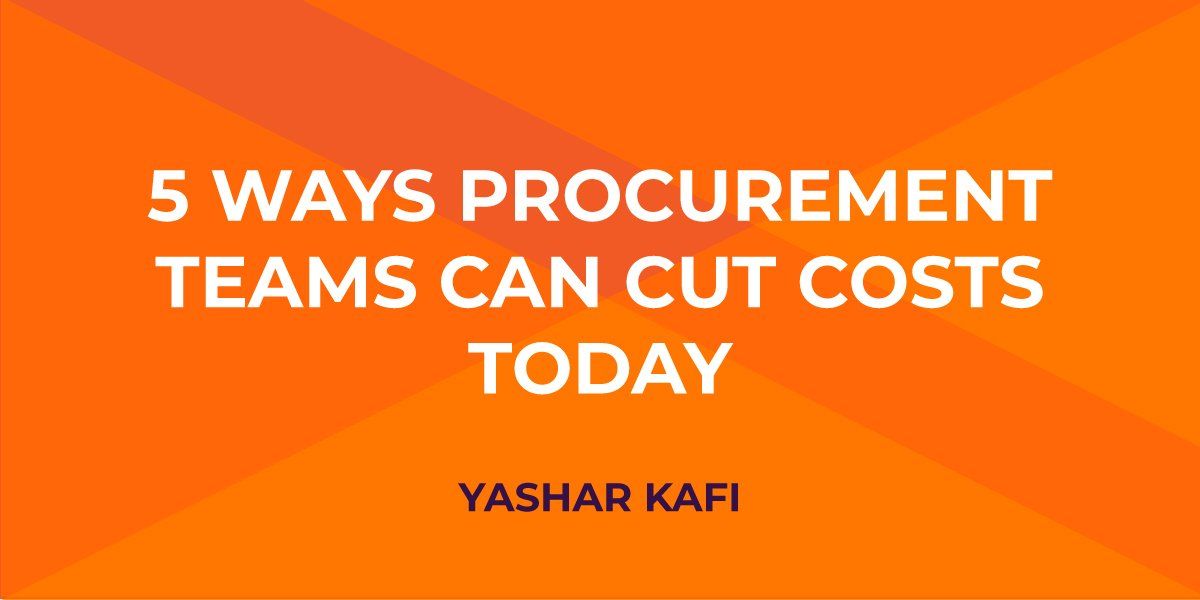5 Ways Procurement Teams Can Cut Costs Today
When it comes to running an organization of any kind, procurement is usually a costly affair. And, according to the Global Chief Procurement Officer (CPO) Study, released by Deloitte in 2016, 74% of CPOs cite that cost reduction should be one of the strongest business priorities in the following years. So, now, during the crisis that we find ourselves in, it’s an excellent time for your C-Suite to sit down and take a look at what cuts they can make to their procurement strategies. And, in the highly-digitized world, there’s one very prevalent factor that can help your organization along the way—data. Let’s take a look at five ways you can leverage the information of others to reduce your costs in trying times.
Cut Previously Necessary Expenditure
As a business, you most likely had some ongoing projects before changes to the everyday status-quo came to fruition. Now that you’ve got no, or very few, staff in the office, stop investing in them. They’ll still be there when this all blows over and, when you consider the financial challenges your business is set to face over the coming months, that money can be better spent elsewhere.
Redistribute Funding Streams
At any time of uncertainty, businesses are forced to chop and change their everyday business operations. This has a huge effect on where cash is coming in and where it is going back out, and more often than not, it could be done far more frugally. Consider this: on the day-to-day running of your business, you may be sending employees on little procurement missions, attending meetings with suppliers and bettering your overall business trajectory.
Well, in today’s climate, with COVID-19 shutting down travel and forcing nationwide social distancing measures, those meetings won’t be conducted face-to-face. Ergo, you won’t be paying for those expensive flights and overnight stays; reallocate the money you were previously spending and put it into the wages and benefits fund, to ensure that staff aren’t subject to the next cut.
Negotiate Your Expenses ─ Freelancers and Consultants
Although everything is a bit amiss at the moment, we can, to some extent, keep up the “business as usual” attitude when it comes to running the workplace. Yes, the bulk of our staff may be homebound, but the freelancers and consultants that we previously outsourced work to were potentially already working from home. The issue is, they tend to command a rather handsome fee for their niche expertise and unique capabilities. Why not have a chat to any that you’ve got on the books and try to negotiate their rates—see if they’ll drop the number, in return for guaranteed work. It’s a win-win. You’ll continue to complete work that your usual staff cannot do, and the professionals will still have an income during trying times where the jobs available are shrinking rapidly.
Adopt Integrated Systems
Now, I have no interest in endorsing staff cuts. Some of the above points can directly alleviate them. That said, with the rise of technology and the huge growth of online services, there is a lot of software and systems that could ensure the smooth running of your business without the staff element. Kissflow, for example, promises to cut the cost of procurement by 65% if you adopt its source-to-pay procurement cloud system. Systems like these do exactly what they say, and remove the necessity of multiple people at various stages of the chain—instead, you’ve got it all in one place, on your laptop.
Bring In The Experts
I said I’d list five ways to cut your costs, but there are just so many ways. That’s where the experts, like the team at AMPlify, come in. We have a team of experienced professionals who are familiar with cost-cutting, cost optimization and spend optimization. We can come in and look across an organization’s entire landscape, easily identifying areas where certain changes would result in immediate, potentially big savings. We can find better, more cost-effective alternatives to your current sources of products and services. But until you get us in, you won’t know. So, get in touch today and let’s see what our specialists can advise to ensure that your organization makes it through these trying times.The body content of your post goes here. To edit this text, click on it and delete this default text and start typing your own or paste your own from a different source.




